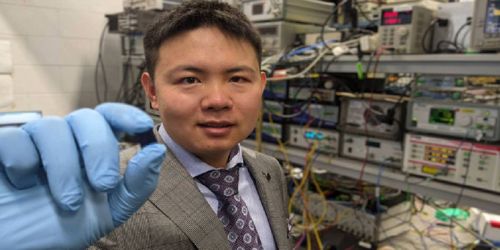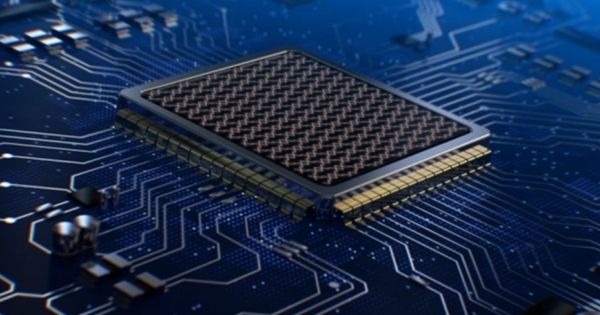Micro-combs are modern systems made up of hundreds of infrared lasers, many of which are carried on a single chip. Compared with other optical sources, they are much smaller, lighter, stronger, and cheaper. The international research team led by the Swinburne University of Technology has demonstrated the world’s fastest and most efficient optical neuromorphic processor for artificial intelligence (AI), which runs faster than 10 trillion operations per second (TeraOPs/s) and is capable of processing ultra-large info. Only imagine, this neuromorphic processor runs faster than 10 trillion operations per second and is capable of processing ultra-large data!
The invention could revolutionize neural networks and neuromorphic processes in general. As reported in the journal Nature, this discovery marks a major leap forward for neural networks and neuromorphic computation in general.
A Swinburne-led team has demonstrated the world’s fastest and most powerful optical neuromorphic processor for artificial intelligence.
Artificial neural networks, a core type of AI, can ‘read’ and execute complex operations with a wide variety of applications in computer vision, natural language processing, facial recognition, voice translation, strategy games, medical diagnosis, and many other fields. Inspired by the biological configuration of the brain’s visual cortex system, artificial neural networks derive core features of raw data to model properties and behavior with unparalleled precision and simplicity.
Led by Swinburne Professor David Moss, Dr. Xingyuan (Mike) Xu (Swinburne, Monash University), and Distinguished Professor Arnan Mitchell of RMIT University, the team has accomplished an extraordinary feat in optical neural networks: significantly speeding up computation and processing capacity. They demonstrated how this creative use of micro-combs offers researchers a snapshot of the processors of the future.

Xingyuan Xu holds one of the optical micro combs used in achieving the world’s fastest neuromorphic processor for artificial intelligence.
The team showed an optical neuromorphic processor running more than 1000 times faster than any previous processor, and the device also handled record-sized ultra-large-scale images—enough to achieve complete facial expression recognition, something that most optical processors were unable to achieve.
“This breakthrough was achieved with ‘optical micro-combs’, as was our world-record internet data speed reported in May 2020,” says Professor Moss, Director of Swinburne’s Optical Sciences Centre and recently named one of Australia’s top research leaders in physics and mathematics in the field of optics and photonics by The Australian.
Although state-of-the-art electronic processors such as Google TPUs can run over 100 TeraOPs/s, this is achieved with tens of thousands of parallel processors. The optical device demonstrated by the team, on the other hand, uses a single processor and has been accomplished using a new technique to simultaneously interleave data in time, wavelength, and spatial dimensions using an optimized micro-comb source.
Micro-combs are relatively modern instruments that operate like a rainbow made up of hundreds of high-quality, single-chip infrared lasers. They are much faster, smaller, lighter, and cheaper than any other source of optics. “In the 10 years since I co-invented them, integrated micro-comb chips have become enormously important and it is truly exciting to see them enabling these huge advances in information communication and processing. Micro-combs offer enormous promise for us to meet the world’s insatiable need for information,” says Professor Moss.
“This processor can serve as a universal ultrahigh bandwidth front end for any neuromorphic hardware – optical or electronic-based – bringing massive-data machine learning for real-time ultra-high bandwidth data within reach,” says co-lead author of the study, Dr. Xu, Swinburne alum and postdoctoral fellow with the Electrical and Computer Systems Engineering Department at Monash University.
“We’re currently getting a sneak-peak of how the processors of the future will look. It’s really showing us how dramatically we can scale the power of our processors through the innovative use of micro combs,” says Dr. Xu. RMIT’s Professor Mitchell says, “This technology is applicable to all forms of processing and communications — it will have a huge impact. Long term we hope to realize fully integrated systems on a chip, greatly reducing cost and energy consumption.”
“Convolutional neural networks have been central to the artificial intelligence revolution, but existing silicon technology increasingly presents a bottleneck in processing speed and energy efficiency,” said Professor Damien Hicks, a core supporter of the research team at Swinburne and the Walter and Elizabeth Hall Institute.
He continues, “This breakthrough shows how a new optical technology makes such networks faster and more efficient and is a profound demonstration of the benefits of cross-disciplinary thinking, in having the inspiration and courage to take an idea from one field and using it to solve a fundamental problem in another.”
















